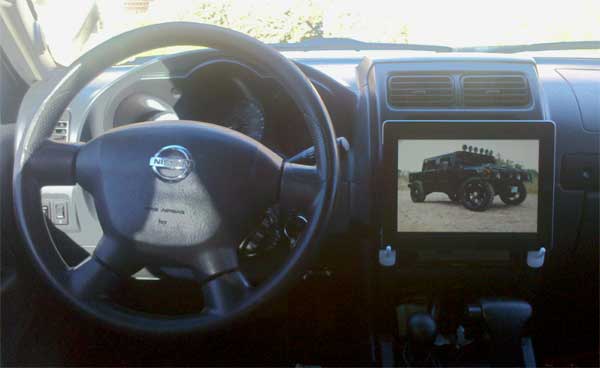Integration of Mobile Devices into Vehicle Infotainment
by Curtis Tingle, Clemson University Automotive Engineering Graduate Student
- Basic Description
-
With the rapid growth of technology in the automotive industry there tends to be more implementation of electronics in various ways throughout the vehicle, and in particular the "connected vehicle". However, what exactly is meant by the term connected vehicle? Connected vehicle can refer to various things from autonomous vehicles to electrified vehicles to intelligent vehicles and most importantly vehicles that use the car as the communication hub through the connection of mobile devices by integrating these devices into vehicle system platforms [1].
The communication hub allows the vehicle to connect to different sources of media that can stream audio and videos by using wireless 3G and 4G networks. In addition the hub allows for various handheld and portable devices, such as tablets and smartphones to be connected to the vehicle [2].
Embedded
With these systems there are three main ways that the information is delivered to the vehicle: Embedded, Tethering and Terminal. Embedded is the most popular method used today. It is platform dependent and the applications and connectivity are embedded into the car. Lexus and Toyota employ an example of this called Enform with Safety Connect [9], BMW has ConnectedDrive [7] and the most popular example of this is GM's OnStar [4]. OnStar was the first popular embedded infotainment module, which focused primarily on safety and security. This system has progressed from just being able to make phone calls and give directions to automated accident detection. OnStar can tell when a vehicle has been in an accident and call for emergency vehicles to respond. It can also pull a vehicle to the side of the road and stop it in the event of car theft.
Tethering
Another way that information is delivered to vehicle is by use of tethering [11]. Tethering is when the application is in the vehicle but the handheld or portable device provides the connection by using BlueTooth or USB. The most popular use of tethering can be seen in Ford's Sync [3]. Sync even has a feature that allows the driver to access applications by using their voice. General Motors is now introducing a competitor to Sync that provides drivers with access to text messaging, e-mail, traffic advisories and other connected-car functions [12]. Since tethering implements the use of handheld devices, it allows access to cloud drives for the user. Whereas embedded modules place emphasis on safety and security, tethering places emphasis on the driver's experience through the infotainment system and the ability to use hands free calling, text messaging and emailing.
Terminal
The final way to deliver information to the vehicle is Terminal. Terminal is least common way to deliver information to the vehicle due to the fact that the application resides in the phone. The phone is connected by using BlueTooth or USB and the display in the vehicle mirrors the display on the phone. The downfall of using tethering that with such a heavy reliance on the mobile device the infotainment system is only as good as the mobile device connected to it.
Shown below is a time line of infotainment systems with the OEM that uses the system as well as the year it was launched on their vehicles:

Other Applications
Some OEMs are putting embedded modules into their vehicles that allow drivers and passengers to access the internet while they are travelling. Also, there are suppliers like AutoNet that offer Wi-Fi aftermarket applications to vehicles [20].
Future for Mobile Device Integration into Infotainment
So what is next for the connected vehicle? Some OEMs plan to create a vehicle application store much like a smartphone application store. Applications would be downloaded directly to the head unit instead of the smartphone or mobile device. Mercedes-Benz introduced a concept car that directly accesses applications on the driver's smartphone [19]. What could the next infotainment system consist of? Possibly the use of tablets as shown in the picture below, where the tablet (in this case an Apple iPad) would serve as the interface to the vehicle's infotainment system.

- For More Information
- [1] Dr. Joachim Taiber, Connected Vehicles - Introduction: Lecture 1 of 3, Oct. 24, 2011.
- [2] Dr. Joachim Taiber, Connected Vehicles - Infrastructure II: Lecture 2 of 3, Oct. 26, 2011.
- [3] Ford Sync, Ford.com.
- [4] OnStar, OnStar Technology, OnStarConnections.com.
- [5] Mercedes-Benz COMMAND Telematics News, telematicsnews.info, Jan. 13, 2011.
- [6] BMW Assist BMW Assist Safety & convenience Services, bmwusa.com.
- [7] BMW ConnectedDrive bmwusa.com.
- [8] Audi Connect, audiusa.com.
- [9] Safety Connect, Toyota.com.
- [10] Lexus Enform, Lexus.com.
- [11] Tethering, Wikipedia.org.
- [12] General Motors' MyLink rivals Ford's Sync infotainment system, David Sedgwick, autoweek.com, Feb. 18, 2011.
- [13] Mercedes-Benz: mbrace, mbusa.com.
- [14] Kia UVO, kia.com.
- [15] Nissan LEAF App: Carwings, NissanUSA.com.
- [17] Hyundai BlueLink, HyundaiUSA.com.
- [18] Fiat: Blue & Me, blueandme.net.
- [19] Mercedes-Benz.tv: Connectivity in the Concept A-class, YouTube, Sep. 5, 2011.
- [20] AutoNet Mobile, autonetmobile.com.
- [21] New Car Safety, Telematics and Infotainment, John Addison, Cleantechblog.com, Oct. 25, 2011.
|
|

